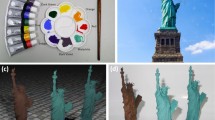Abstract
The ohmic curing of two silver micro-particle inks was studied. Silver lines of 35 to 75 µm thick were printed on a mixture of polycarbonate and acrylonitrile butadiene styrene (PC+ABS) substrate and on a mineral reinforced Nylon 6 thermoplastic, using a laboratory-made system based on a volumetric dosing dispenser. After 48 h of stabilization in ambient conditions, a current is applied through the printed lines with an imposed intensity value and application time in order to cure the silver inks. Evolutions of the temperature and the resistivity of silver tracks were followed during the process. Printed thermoplastics were characterized at the end of the process in order to check the absence of deformation due to the curing treatment. The study showed that the ohmic curing led to better electrical performances than an oven process with a considerable time saving. Most of the printed line resistivity drop occurred in the first 30 s of the treatment. The ohmic curing induced a local increase of temperature located in the printed line and avoided damaging the substrates, which makes the process compatible with thermal sensitive substrates. Therefore, the ohmic curing is an efficient low-cost process to cure silver micro-particle inks that could be easily implemented at an industrial scale.
Graphic abstract












Similar content being viewed by others
References
M. Dyson, K. Ghaffarzadeh, Flexible Hybrid Electronics 2020–2030: Applications, Challenges, Innovations and Forecasts. IDTechEx Research. (2020)
K. Ghaffarzadeh, R. Collins, In-Mold Electronics 2020–2030: Technology, Market Forecasts, Players. IDTechEx Research. (2020)
W. Wu, Nanoscale 9, 7342 (2017).
I. Reinhold, C.E. Hendriks, R. Eckardt, J.M. Kranenburg, J. Perelaer, R.R. Baumann, and U.S. Schubert, J. Mater. Chem. 19, 3384 (2009).
B. Polzinger, F. Schoen, V. Matic, J. Keck, H. Willeck, W. Eberhardt, H. Kueck, UV-sintering of inkjet-printed conductive silver tracks. in 2011 11th IEEE International Conference on Nanotechnology, IEEE, Portland, OR, USA. vol. 201 (2011).
M.K. Kim, J.Y. Hwang, H. Kang, K. Kang, S.-H. Lee, S.-J. Moon, Laser sintering of the printed silver ink. in 2009 IEEE International Symposium on Assembly and Manufacturing, IEEE, Seoul, South Korea. Vol. 155 (2009)
K.A. Schroder, S.C. McCool, and W.F. Furlan, NSTI-Nanotech 3, 198 (2006).
V. Thenot, Impression et recuits sélectifs d’encres métalliques sur papier – Optimisation des propriétés électriques de boucles RFID-HF en vue d’une production industrielle, PhD. thesis. (2017)
M. Allen, A. Alastalo, M. Suhonen, T. Mattila, J. Leppaniemi, and H. Seppa, IEEE Trans. Microwave Theory Techn. 59, 1419 (2011).
M.L. Allen, M. Aronniemi, T. Mattila, A. Alastalo, K. Ojanperä, M. Suhonen, and H. Seppä, Nanotechnology 19, 175201 (2008).
P. Escobedo, M.A. Carvajal, J. Banqueri, A. Martinez-Olmos, L.F. Capitan-Vallvey, and A.J. Palma, IEEE Access 7, 1909 (2019).
O. Kravchuk, Y. Bobitski, M. Reichenberger, Electrical sintering of inkjet printed sensor structures on plyimide substrate. in 2016 IEEE 36th International Conference on Electronics and Nanotechnology (ELNANO), IEEE, Kyiv, Ukraine, vol. 104 (2016)
O. Kravchuk, Y. Bobitski, M. Reichenberger, Laser curing of inkjet printed strain gauge structures. in MIXDES - 23rd International Conference Mixed Design of Integrated Circuits and Systems, IEEE, Lodz, Poland, vol. 343 (2016)
H. Lee, D. Kim, I. Lee, Y.-J. Moon, J.-Y. Hwang, K. Park, and S.-J. Moon, Jpn. J. Appl. Phys. 53, 05HC07 (2014).
J. Perelaer, M. Klokkenburg, C.E. Hendriks, and U.S. Schubert, Adv. Mater. 21, 4830 (2009).
W. Luo, W. Hu, and S. Xiao, J. Phys. Chem. C 112, 2359 (2008).
Ph. Buffat, and J.-P. Borel, Phys. Rev. A 13, 2287 (1976).
F.Liwei, Laser curing of inks for Plastic Electronic Applications. University of Liverpool PhD. thesis. (2014)
D.A. Roberson, R.B. Wicker, L.E. Murr, K. Church, and E. MacDonald, Materials 4, 963 (2011).
J. Niittynen, R. Abbel, M. Mäntysalo, J. Perelaer, U.S. Schubert, and D. Lupo, Thin Solid Films 556, 452 (2014).
A.J. Lopes, I.H. Lee, E. MacDonald, R. Quintana, and R. Wicker, J. Mater. Process. Technol. 214, 1935 (2014).
H.W. Tan, N. Saengchairat, G.L. Goh, J. An, C.K. Chua, and T. Tran, Adv. Mater. Technol. 5, 1900897 (2020).
D.A. Roberson, R.B. Wicker, and E. MacDonald, J. Electr. Mater. 41, 2553 (2012).
B. Niese, U. Urmoneit, P. Amend, S. Roth, M. Schmidt, Laser Sintering of Silver Ink for Generation of Embedded Electronic Circuits in Stereolithography Parts. in Lasers in Manufacturing Conference (2015)
F. Tricot, C. Venet, D. Beneventi, D. Curtil, D. Chaussy, T.P. Vuong, J.E. Broquin, and N. Reverdy-Bruas, RSC Adv. 8, 26036 (2018).
J. Perelaer, C. Hendriks, A.W.M. de Laat, and U.S. Schubert, Nanotechnoloy 20, 165303 (2009).
B. Wałpuski, and M. Słoma, Adv. Eng. Mater. 23, 2001085 (2021).
K.C. Yung, X. Gu, C.P. Lee, and H.S. Cho, Ink-jet printing and camera flash sintering of silver tracks on different substrates J. Mater. Process. Technol. 210, 2268 (2010).
Acknowledgments
This work was made within the industrial chair MINT supported by the partnership Foundation of Grenoble INP for which Schneider Electric is a sponsor. The study was realised at the LGP2 laboratory. LGP2 is part of the LabEx Tec 21 (Investissements d'Avenir – grant agreement no. ANR-11-LABX-0030) and of PolyNat Carnot Institute (Investissements d'Avenir – grant agreement no. ANR-16-CARN-0025-01). This research was made possible thanks to the facilities of the TekLiCell platform funded by the R´egion Rhˆone-Alpes (ERDF: European regional development fund).
Author information
Authors and Affiliations
Corresponding author
Ethics declarations
Conflicts of interest
There are no conflicts of interest to declare.
Additional information
Publisher's Note
Springer Nature remains neutral with regard to jurisdictional claims in published maps and institutional affiliations.
Rights and permissions
About this article
Cite this article
Tricot, F., Venet, C., Beneventi, D. et al. Ohmic Curing of Silver Micro-Particle Inks Printed on Thermoplastics. J. Electron. Mater. 50, 6183–6195 (2021). https://doi.org/10.1007/s11664-021-09145-7
Received:
Accepted:
Published:
Issue Date:
DOI: https://doi.org/10.1007/s11664-021-09145-7




